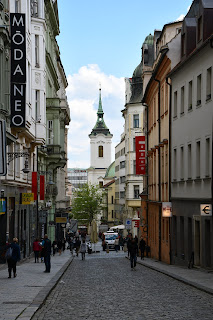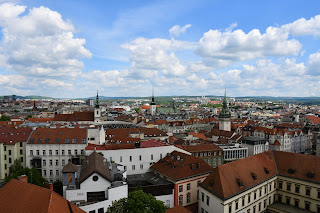Brno and Western Moravia
For reasons unknown to me, my dad decided to buy bumblebees. Even more incomprehensibly, he decided to buy them in Brno, a city two hundred kilometres away. While I have yet come to comprehend why exactly we need Moravian bumblebees, this strange purchase did have one upside – we got to make a trip to the second largest city in the Czech Republic, a city I had never visited before.
We arrived in Brno shortly after 10 AM but lost a lot of
time trying to find a parking spot near one of Brno’s major attractions,
Špilberk Castle. When a spot was eventually freed up, we found that the pathway
we were hoping to ascend was closed, so we decided to park nearer to the city
centre. We did not have enough time, therefore, to tour the castle, but we did
see much of what Brno has to offer: various churches, elegant city
architecture, and a town hall with a taxidermized crocodile from the sixteenth
century (the “Brno Dragon”). My sister and I also clambered up the Cathedral of
Saint Peter and Paul, where I found out that my fear of heights has not eased
in the slightest since the last time I tried something similar.
On a whim, we decided to visit Třebíč. This was after my mum called my dad
to express dissatisfaction about the planned purchase of bumblebees and the
entire plan was called off. Yes, that is the sort of people we are. People who
will drive 200 kilometres to Brno to buy bumblebees and then decide we don’t
want them after all.
We began our tour of Třebíč with a stop at the Basilica of St.
Procopius, which is inscribed in the list of UNESCO World Heritage Sites
together with the town’s Jewish quarter. The basilica, which dates to the twelfth
century, is particularly noteworthy for its fusing of Romanesque and Gothic
features. Our subsequent visit to the Jewish quarter left a little to be
desired – we joked that perhaps the UNESCO officers who assessed this quaint,
but rather unremarkable place, probably neglected to visit Prague’s Jewish
quarter on their way to Třebíč. The
Jewish cemetery was very glamorous though.
Our last stop was the city Jihlava, which almost straddles
the Moravian-Czech border. Of the cities we visited, Jihlava was perhaps the
most pleasant: not as vast and as difficult to fit into a tight schedule as
Brno, and not as small as Třebíč. I think the most impressive sight in the city
is the Church of Saint Ignatius of Loyola, a seventeenth-century structure that
towers over Masaryk Square. Also worth seeing is the Gate of the Holy Mother,
the only remaining gate of the city’s original fortifications. It was
originally built in the thirteenth century but has undergone several
reconstructions since then – hence the eclectic exterior.
The same
The Town Hall in Jihlava
The Church of Saint Ignatius of Loyola
Another picture of the Town Hall
Another picture of the Church of Saint Ignatius
An interesting view
A town building with sgraffiti
The Church of the Assumption
The Gate of the Holy Mother
The same
The Church of the Assumption from another perspective
The Church of Saint James the Greater








































































Comments
Post a Comment